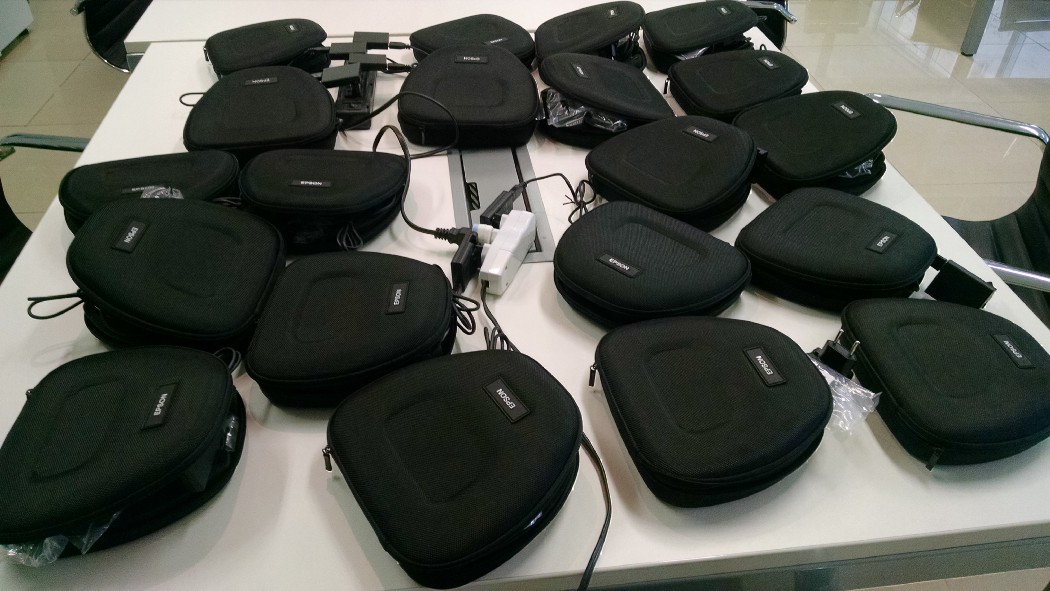Augmenting Field Services with Smartglasses
 In the beginning of 2016 one of the largest elevator manufacturers needed help to improve the effectiveness of their field services personnel.
The company's innovation department had bought a Google Glass but was unable to successful deploy a working solution.
As technology director for eyllo, I traveled to Porto Alegre to help them. I took with me smart-glasses, laptop, cellphone, etc. and demoed our solution.
Our eyllo Field Service solution is an application for asset management and remote expert.
In the beginning of 2016 one of the largest elevator manufacturers needed help to improve the effectiveness of their field services personnel.
The company's innovation department had bought a Google Glass but was unable to successful deploy a working solution.
As technology director for eyllo, I traveled to Porto Alegre to help them. I took with me smart-glasses, laptop, cellphone, etc. and demoed our solution.
Our eyllo Field Service solution is an application for asset management and remote expert.
The components of our remote expert solutions are: an app running on smart-glasses, a web page that can be logged into using a regular web browser and services running o the cloud to manage the connection between the smart-glasses and the web and also configure the platform. The smart-glasses connects to the internet through WiFi, which can be a mobile hotspot created by a cell phone.
Initial demo
I arrived at the company's innovation lab in Porto Alegre and set up the solution to start the demonstration. The innovation manager chose one of the old-time field technicians, handed him the smart-glasses and asked him to go to the test elevator and execute some standard tasks using our solution. The technician walked towards the elevator without any difficult and performed the tasks efficiently, since our solution leaves the hands free to use the necessary tools for the task. Also, the technician experimented another benefit of our platform: he was in contact with a remote expert while executing his task.
As a result of the successful demo, the company's innovation group authorized a six-month pilot using seven smart-glasses in Porto Alegre, Rio de Janeiro and Recife connected to experts at a central location in Porto Alegre.
The quality of cell phone services in Brazil is still no on par with the quality available in the US or Europe. There are limitations in coverage and bandwidth. More specifically, transmitting video is not an easy task, since it puts more stress on an already limited network. Also, It is hard to have good quality signal inside buildings. In order to overcome the limitations of cell phone telephony in Brazil, we use an adaptive video compression protocol. Such approach adjusts the video quality accordingly to the available wireless bandwidth available for transmission at the very moment.
To allow for a successful pilot, we evaluated the cell tower distribution and determined the signal quality at different regions of the cities where the pilot took place. Such data was used to prioritize the locations with highest likelihood of success. Moreover, together with the customer, we developed a process to properly position the cell phone and maximize the connection quality before the beginning of the maintenance procedure.
Unexpected Access
Vista has daemons that monitor the various components to assure they are working properly, generate logs and usage reports. In the last week of October, one of the automatic reports indicated multiple uses initiated in Chile. Since the pilot project was supposed to take place in three different cities in Brazil, our team started to double check the code to try to figure out why the system was thinking that someone was using our solution in Chile.
In the evening, while I was going through logs and recent code changes, I received a phone call from the innovation manager. He was in Chile and called me to tell that our solution works in other countries besides Brazil. He said that Vista was used to connect a field service technician in Chile with an expert in Porto Alegre, Brazil and that the video quality was even better than they have seen in previous calls connecting field personnel in Brazil.
The successful use of our solution to connect a field technician in Chile with a remote expert in Brazil increased the customer's confidence to move the project to the next phase. In phase two, the number of smart-glasses was increased to a total of thirty one and the region expanded to include other countries in Latin America, such as Costa Rica, Peru, Mexico, …
Phase Two
After the customer gave the go-ahead for the following phase, we put an order for new smart-glasses. After a little bit over a month of wait, we receive the twenty four new devices. The picture bellow show the smart-glasses receiving an initial charge after they arrived in our office.

In the beginning of 2017, we configured twenty four smart-glasses, installed our solution, and individually tested, together with the customer, each unit. In February, all units left our office ready to go into production in Brazil and other countries in Latin America.
We are currently talking to various prospects in aviation, healthcare, energy, auto industry, among others, to set up more pilot projects and test our solution. The companies we are talking are starting to realize that the benefits of our solution go beyond cost cutting and can actually allow for a smother and more efficient operation, increasing asset availability and reducing the time it takes to respond to customer requests.
